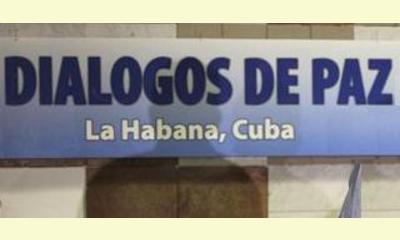|
|
Colombian President to Reactivate National Peace Commission
un articulo por Prensa Latina
Colombian President Juan Manuel Santos, announced
today [March 26] he will reactivate the National
Peace Commission, created in the 90s to promote a
culture of peace and to support the dialogue between
the Government and the Guerrilla FARC-EP.

click on photo to enlarge
In a meeting with governors of the central
department of Tolima, the Executive assured that
the process installed in November 2012 in Cuba is
sufficiently mature to take that step and convoke
that institution, created two decades ago under
the government of former President Ernesto Samper
(1994-1998).
Santos affirmed he has answered many petitions of
social organizations to this end. I am going to
convoke the Commission in which many
representatives of civil society participate, to
use that institution and promote a culture of
peace, he reiterated.
After thanking the permanent support of governors
to the talks, the President announced the
resignation of Minister for the Social Dialogue,
Luis Eduardo Garzon, who besides participating in
his campaign for reelection, will play a
fundamental role in the coordination of the
National Peace Commission.
The peace process installed a little over a year
ago, focuses discussión on a six-point agenda from
which there are already partial agreements on the
topic of agrarian development on which there are
already partial comprehensive agrarian development
and political participation.
At present, the parts in dialogue approach the issue
of solution to the problem of illicit drugs.
(Click here for a Spanish version of this article)
|








|
DISCUSSION
Pregunta(s) relacionada(s) al artículo :
What is happening in Colombia, Is peace possible?
* * * * *
Comentario más reciente:
The force of non-violence constrains the force of arms!
Colombia - the force of peaceful resistance -
At the beginning of July, the rebels of the armed revolutionary forces of Colombia (FARC) kidnapped a 51 year old Swiss, and his Colombian assistant who worked in the Indian communities of Cauca province where they were setting up development projects by building schools and community production enterprises.
The news of the kidnapping was spread through all the villages and 2000 Indians set out to pursue the 400 guerillas. They reached them at an elevation of over 4000 meters (12,000 feet), encircled them, and without any weapon, constrained them to release the 2 hostages! (After 2 days, the hostages were released).
This release, obtained through "peaceful resistance" has raised a national debate: the possibility of resisting violence without needing to use weapons has demonstrated the effectiveness of human solidarity movements.
"I will return, and I will then be millions" prophesied the Aymara Indian leader Tapak Katari, in 1781, at the time of his execution by the Spanish conquistadors.
100 million in 1492, the Indians were no more than 4,5 million one century and half later. Currently there are 44 million Indians populating Latin America.
In spite of their great diversity, the Indian movements take on more and more importance. In Ecuador, Guatemala, Bolivia, Peru, Mexico or Colombie they are opposed to the neoliberal system that governs the Americas, while protesting against the imposition of the American economic market. . ... continuación.

|
|









